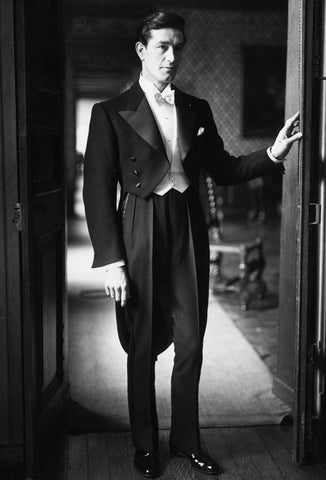
Wearing white tie // Wearing a tailcoat
Share
Originally, wearing a tailcoat was considered the basis of the formal dress form, which was the highest level of elegance. The original form of white tie began to fade in the 1930s, when Edward VIII, Prince of Wales, attended a dinner in a short evening coat - from then on, the need and popularity of the tailcoat began to fade. Since the end of the 20th century, white tie have been worn only for the most formal occasions, such as a state dinner, official balls and galas such as the Vienna Opera Ball, the Nobel-prize winning in Stockholm, the Mardi Gras balls in New Orleans or the Oscars gala.

Adorned with a row of buttons on each side the jacket is black, short in the front but ends at the back with two long pointed tails worn with a stiff, hardened white canvas shirt, matching white waistcoat with a row of buttons and a white bow tie. The modern detachable collar can be traced back to the 1820s - when an American lady had enough of washing the whole shirt when the collar got dirty, so she cut off the collar and that's it. Detachable collar was born. This allowed the shirt to be used again and made it easier to clean the collar. The high-waisted black trousers are made of the same material as the jacket, the seam on the outside is covered with a decorative strip of one or two shiny satins, for which black patent leather Oxford shoes are the classic choice. Optionally black top hat, white gloves, white scarf or pocket watch can be worn as an accessory.
At a white tie event only a tailcoat is allowed, while a tailcoat and a tuxedo can be worn at a black tie event, although in this case wearing a tailcoat may result in "over-dressing" the hist, which is advised to be avoided . Wearing a tailcoat has retained its special, exclusive effect, as it can still be worn only for the noblest, most elegant occasions.

//HUN
Originally, the wearing of a tailcoat was considered the basis of formal dress, which was considered the highest level of elegance. The original form of the tailcoat began to recede into the background in the 1930s, when VIII. Edward, Prince of Wales, attended a dinner in a short evening coat - from then on, the necessity and popularity of the tailcoat began to fade. Since the end of the 20th century, tailcoats have been worn only for the most formal occasions, such as a state dinner, official balls and galas, such as the Vienna Opera Ball, the Nobel Prize ceremony in Stockholm, the Mardi Gras balls in New Orleans or the Oscar gala.

Structure
A black jacket decorated with a row of buttons on both sides, but which cannot be buttoned together, is short in the front and ends in two long pointed tails in the back, worn with a white linen shirt with a stiff, stiff chest, a matching white single-breasted, "deep-cut" waistcoat, and a white bow tie. The modern detachable collar can be traced back to the 1820s - when an American lady was said to have had enough of always having to wash the whole shirt when the collar got dirty, so she cut the collar off and thus the detachable collar was born. This allowed the shirt to be put on again and made cleaning the collar easier. The high-waisted black pants are made of the same material as the jacket, the seam on the outside is covered by one or two decorative strips made of shiny satin, for which black patent leather oxford shoes are the classic choice. Optional accessories include a black top hat, white gloves, white scarf and pocket watch.

At white tie events, only a tailcoat is allowed, while at a black tie event both a tailcoat and a tuxedo can be worn, although in this case wearing a tailcoat may result in the host being "overdressed", which is recommended to be avoided. Wearing a tailcoat has retained its special, exclusive effect, as it can still only be worn on the noblest and most elegant occasions.